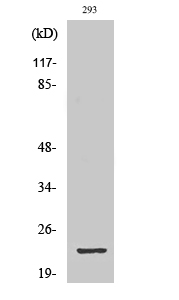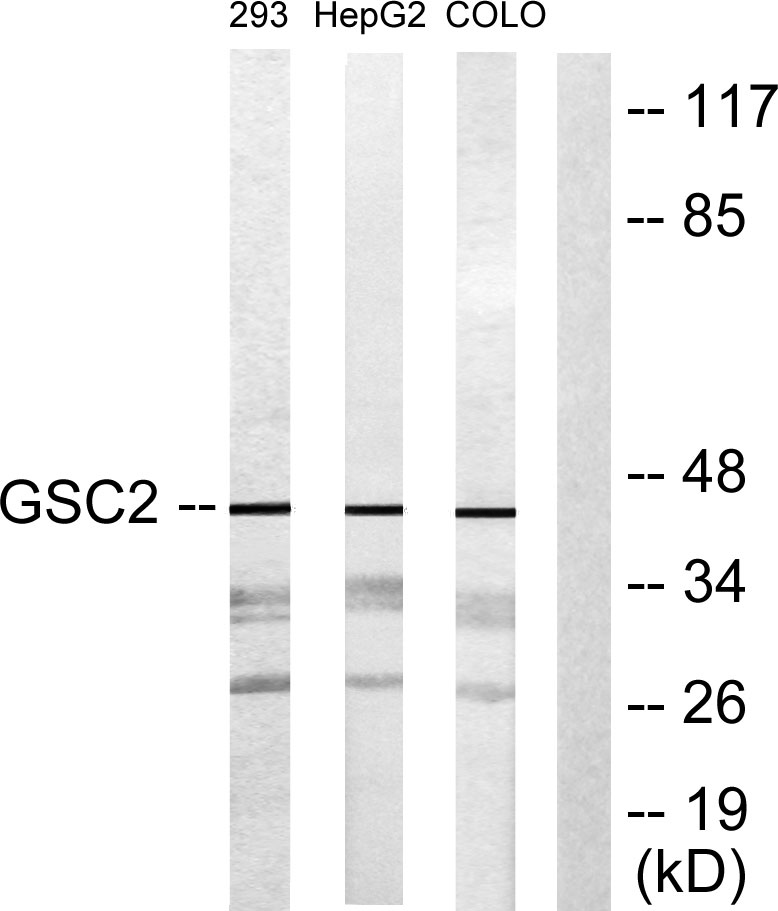GSC2 Polyclonal Antibody
- Catalog No.:YT2079
- Applications:WB;ELISA
- Reactivity:Human;Mouse
- Target:
- GSC2
- Gene Name:
- GSC2
- Protein Name:
- Homeobox protein goosecoid-2
- Human Gene Id:
- 2928
- Human Swiss Prot No:
- O15499
- Mouse Swiss Prot No:
- P56916
- Immunogen:
- The antiserum was produced against synthesized peptide derived from human GSC2. AA range:131-180
- Specificity:
- GSC2 Polyclonal Antibody detects endogenous levels of GSC2 protein.
- Formulation:
- Liquid in PBS containing 50% glycerol, 0.5% BSA and 0.02% sodium azide.
- Source:
- Polyclonal, Rabbit,IgG
- Dilution:
- WB 1:500 - 1:2000. ELISA: 1:20000. Not yet tested in other applications.
- Purification:
- The antibody was affinity-purified from rabbit antiserum by affinity-chromatography using epitope-specific immunogen.
- Concentration:
- 1 mg/ml
- Storage Stability:
- -15°C to -25°C/1 year(Do not lower than -25°C)
- Other Name:
- GSC2;GSCL;Homeobox protein goosecoid-2;GSC-2;Homeobox protein goosecoid-like;GSC-L
- Observed Band(KD):
- 25kD
- Background:
- Goosecoidlike (GSCL), a homeodomain-containing gene, resides in the critical region for VCFS/DGS on 22q11. Velocardiofacial syndrome (VCFS) is a developmental disorder characterized by conotruncal heart defects, craniofacial anomalies, and learning disabilities. VCFS is phenotypically related to DiGeorge syndrome (DGS) and both syndromes are associated with hemizygous 22q11 deletions. Because many of the tissues and structures affected in VCFS/DGS derive from the pharyngeal arches of the developing embryo, it is believed that haploinsufficiency of a gene involved in embryonic development may be responsible for its etiology. The gene is expressed in a limited number of adult tissues, as well as in early human development. [provided by RefSeq, Jul 2008],
- Function:
- developmental stage:Expressed in early human development as well as in a limited number of adult tissues.,disease:May play a part in the etiology of the velocardiofacial/DiGeorge syndrome (VCFS/DGS), a developmental disorder characterized by structural and functional palate anomalies, conotruncal cardiac malformations, immunodeficiency, hypocalcemia, and typical facial anomalies. Most cases result from a deletion of chromosome 22q11.2 (the DiGeorge syndrome chromosome region, or DGCR).,function:May have a role in development. May regulate its own transcription. May bind the bicoid consensus sequence TAATCC.,similarity:Belongs to the paired homeobox family. Bicoid subfamily.,similarity:Contains 1 homeobox DNA-binding domain.,tissue specificity:Detected in adult testis and pituitary, and in 9-10 week fetal tissue (thorax). Probably expressed in other tissues at low levels.,
- Subcellular Location:
- Nucleus .
- Expression:
- Detected in adult testis and pituitary, and in 9-10 week fetal tissue (thorax). Probably expressed in other tissues at low levels.
- June 19-2018
- WESTERN IMMUNOBLOTTING PROTOCOL
- June 19-2018
- IMMUNOHISTOCHEMISTRY-PARAFFIN PROTOCOL
- June 19-2018
- IMMUNOFLUORESCENCE PROTOCOL
- September 08-2020
- FLOW-CYTOMEYRT-PROTOCOL
- May 20-2022
- Cell-Based ELISA│解您多样本WB检测之困扰
- July 13-2018
- CELL-BASED-ELISA-PROTOCOL-FOR-ACETYL-PROTEIN
- July 13-2018
- CELL-BASED-ELISA-PROTOCOL-FOR-PHOSPHO-PROTEIN
- July 13-2018
- Antibody-FAQs
- Products Images

- Western Blot analysis of various cells using GSC2 Polyclonal Antibody diluted at 1:1000 cells nucleus extracted by Minute TM Cytoplasmic and Nuclear Fractionation kit (SC-003,Inventbiotech,MN,USA).

- Western blot analysis of lysates from 293, HepG2, and COLO205 cells, using GSC2 Antibody. The lane on the right is blocked with the synthesized peptide.



